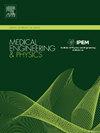股骨及胫骨小梁非线性应力松弛特性的计算建模
IF 1.7
4区 医学
Q3 ENGINEERING, BIOMEDICAL
引用次数: 0
摘要
骨科重建的计算模型依赖于骨材料的特性,但在数值模拟中经常忽略骨小梁的粘弹性行为。应力松弛的加入对于模拟无骨水泥种植体初级稳定性的模型的准确性具有重要意义。本研究基于单轴应力松弛实验,建立了描述人小梁骨非线性粘弹性行为的材料模型。探讨了骨矿物质密度(BMD)与应力松弛的关系,并对材料模型进行了特定样品的有限元模拟。对股骨远端和胫骨近端圆柱形人骨小梁标本进行应力松弛试验,连续4天进行0.2 ~ 0.8%应变压缩30分钟。实验数据外推至24小时。股骨和胫骨标本的应力松弛水平相似,平均应力松弛率为54.4%,最大应力松弛率为81.6%。利用改进的叠加模型,捕获了试件特有的非线性应力松弛行为。然而,当样品被整体考虑时,没有发现外加应变、骨密度和粘弹性响应之间的相关性。因此,结合现有的bmd -刚度关系,在每个单独试件的有限元模拟中实现了平均应力松弛水平。虽然有限元模型平均高估了64%的整体刚度,但它们能够充分捕捉到应力松弛反应。本文章由计算机程序翻译,如有差异,请以英文原文为准。

Characterization of nonlinear stress relaxation of the femoral and tibial trabecular bone for computational modeling
Computational models of orthopedic reconstructions are reliant on bone material properties, but viscoelastic behavior of trabecular bone is often ignored in numerical simulations. The inclusion of stress relaxation could be of importance for the accuracy of models simulating the primary stability of cementless implants. In this study, a material model to describe the nonlinear viscoelastic behavior of human trabecular bone was constructed based on uniaxial stress relaxation experiments. The relationship of bone mineral density (BMD) and stress relaxation was explored, and the material model was implemented in sample-specific finite element (FE) simulations.
Cylindrical trabecular human bone specimens, from the distal femur and proximal tibia, were subjected to stress relaxation tests, undergoing compression with strains from 0.2 % to 0.8 % for 30 min on four consecutive days. The experimental data were extrapolated to 24 h. Similar levels of stress relaxation were found for femoral and tibial specimens, with an average 54.4 % stress relaxation and a maximum level of 81.6 %. Using a modified superposition model, the specimen-specific nonlinear stress relaxation behavior was captured. However, when the samples were considered collectively, no correlation was found between applied strain, BMD and the viscoelastic response. Therefore, the average level of stress relaxation in combination with existing BMD-stiffness relationships were implemented in FE simulations for each individual specimen. While the FE models, on average, overestimated the overall stiffness by 64 %, they were able to adequately capture the stress relaxation response.
求助全文
通过发布文献求助,成功后即可免费获取论文全文。
去求助
来源期刊

Medical Engineering & Physics
工程技术-工程:生物医学
CiteScore
4.30
自引率
4.50%
发文量
172
审稿时长
3.0 months
期刊介绍:
Medical Engineering & Physics provides a forum for the publication of the latest developments in biomedical engineering, and reflects the essential multidisciplinary nature of the subject. The journal publishes in-depth critical reviews, scientific papers and technical notes. Our focus encompasses the application of the basic principles of physics and engineering to the development of medical devices and technology, with the ultimate aim of producing improvements in the quality of health care.Topics covered include biomechanics, biomaterials, mechanobiology, rehabilitation engineering, biomedical signal processing and medical device development. Medical Engineering & Physics aims to keep both engineers and clinicians abreast of the latest applications of technology to health care.
 求助内容:
求助内容: 应助结果提醒方式:
应助结果提醒方式:


